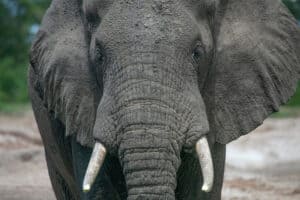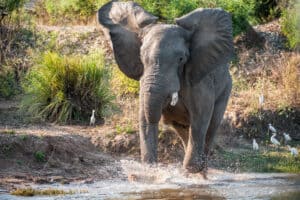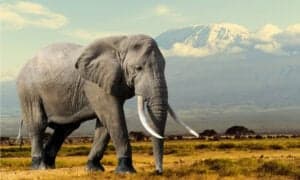Elephants’ massive ears are one of their most famous characteristics. Alongside their long trunks, an elephant’s big ears are the first thing we see. Their large ears easily give the animals a commanding presence.
While extra-large ears help with hearing, that’s not the reason for their size.
Elephants have giant, floppy ears because they regulate body temperature in extreme heat.
African elephants are the biggest land mammals in the world. African and Asian elephants can weigh upwards of 13,000 to 15,000 pounds.
They have massive bodies to try and keep cool.
Their large bodies, combined with their hot habitats, mean it’s hard to cool elephants down.
Plus, elephants can only sweat from their feet, so it’s easier to overheat. Full-body sweating would likely cause dehydration since the climate is too hot.
Why do Elephants have such Big Ears?
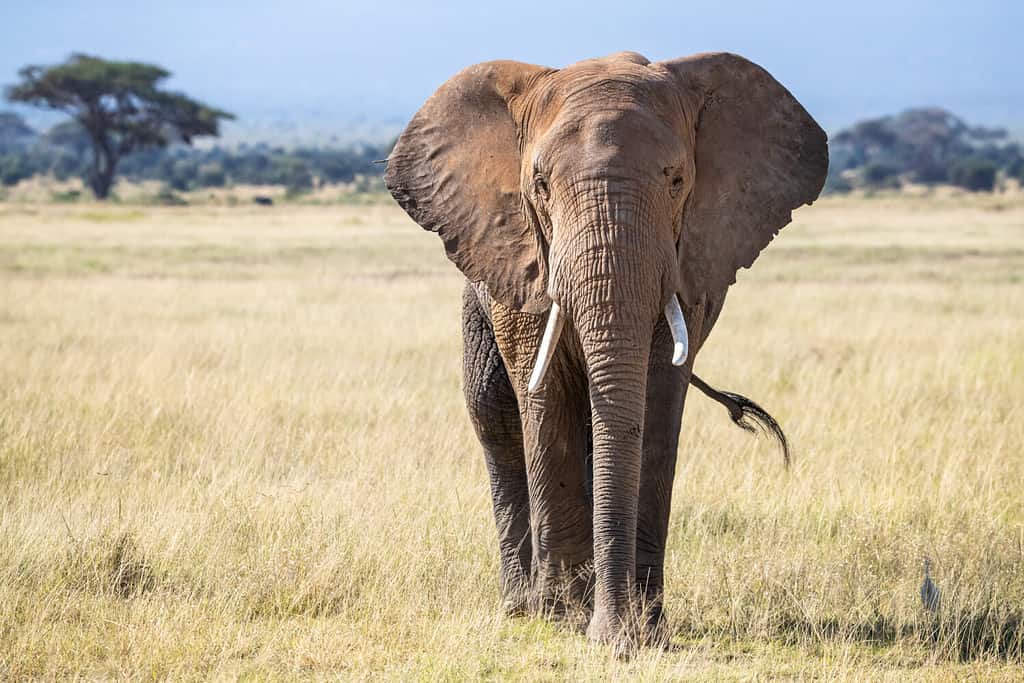
The blood vessels in elephants’ big ears keep them cool.
©Jane Rix/Shutterstock.com
Elephants have massive ears to help regulate their body temperature. They have huge blood vessels in their ears. The vessels allow for excellent blood circulation. As the blood flows through the ears, it cools down.
The cooled blood then circulates through the rest of the body. The elephant’s body temperature lowers as the cooled blood moves through it.
Elephants encourage blood circulation by flapping their ears like giant fans.
Flapping their ears also helps slightly cool down the front of their body as they create a slight breeze. Plus, flapping their ears keeps pesky insects at bay.
The large blood vessels also help elephants get rid of excess heat in their body when they flap their ears. The blood vessels release extra heat from the body with the movement of ear flapping.
The blood vessels are so large that you can see them from the back of the elephant’s ears.
Do Big Ears Give Elephants Better Hearing?
Elephant ears are designed to keep the body cool. The ears’ large size also gives elephants remarkable hearing.
Researchers think the large outer ear may help direct sounds to the inner ear, making it easier to hear. Having excellent hearing helps elephants better detect possible threats.
Big Ears are Great for Communication
Elephants are excellent communicators. They use vocalizations, vibrations, and body language to talk to each other.
They can move their ears to tell fellow animals about their intentions.
Elephants have more facial neurons than any other land mammal in the world. The abundance of neurons gives them remarkable control of their ear movements. African elephants have 63,000 neurons. Smaller Asian elephants have 54,000 neurons.
For example, elephants often flare their ears. They may do this because they are excited or trying to fend off predators or challengers.
They will even flick their ears forward to show they are listening to something.
African and Asian Elephants have Different Ear Sizes
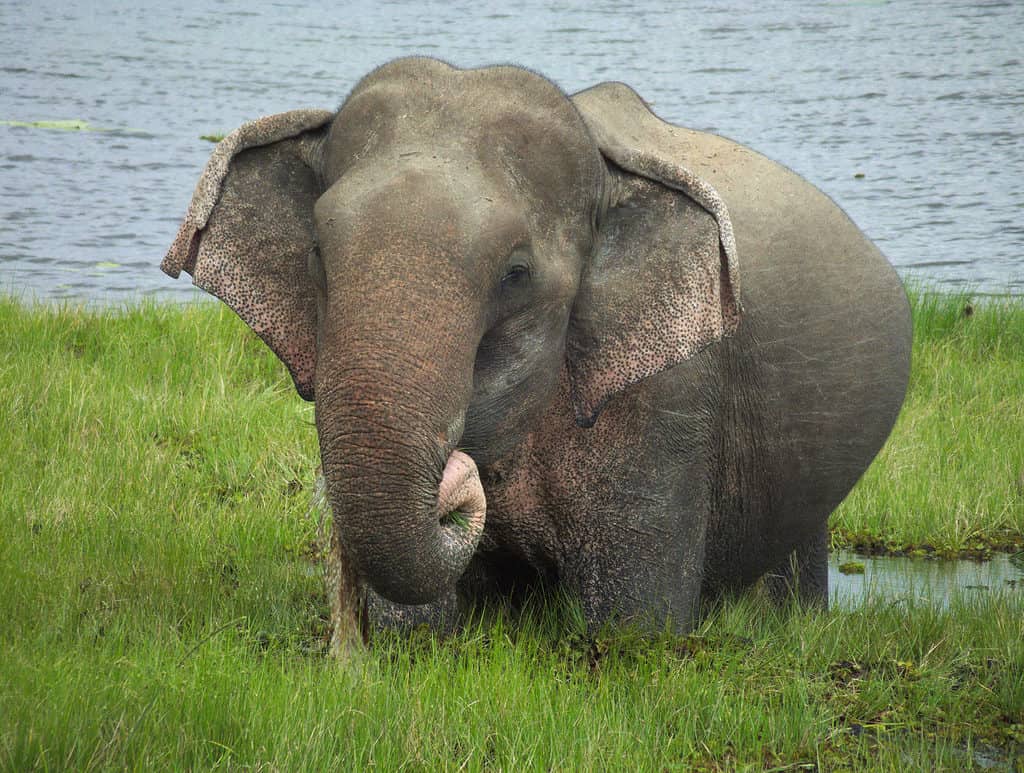
Asian elephants have smaller ears than African elephants because their habitat doesn’t get as hot.
©iStock.com/Lekamalage
African and Asian elephants have ears that are different sizes and shapes. African elephants have larger ears than Asian elephants since their bodies are larger.
Many describe African elephants as having ears that resemble the shape of Africa.
Likewise, Asian elephants have ears that more closely resemble India.
FAQs
Why do African elephants have bigger ears than Asian elephants?
African elephants have larger ears because of their body sizes and habitat.
Asian elephants are generally smaller than African elephants. Their ears don’t need to be as big.
Africa’s climate also tends to be far hotter than Asia’s. African elephants need more prominent ears to help them get rid of the extra heat.
How many kinds of elephants are there?
There are three kinds of elephants: African bush, African forest, and Asian elephants.
African bush and forest elephants are pretty similar. African forest elephants are slightly smaller because they must squeeze through trees.
African elephants differ from Asian elephants because they have larger ears. They also have round heads, and both males and females can grow tusks.
Asian elephants have smaller ears and heads with two domes. Plus, only males can grow tusks.
Why do elephants have tusks?
Tusks are massive incisor teeth that elephants use for defense and eating.
They use their tusks to dig up plants’ roots and peel bark off of trees.
For defense, the sharp tusks are excellent for fighting off dangerous predators.
Why do elephants have long trunks?
Elephants have long trunks for drinking, grasping, and breathing. The trunks are long and incredibly strong, with about 150,000 muscles. They use those muscles to suck water into their bodies and to grasp things.
Elephants are also great swimmers. They use their long trunks like a snorkel while they swim so that they can still breathe.
Why do elephants have ripped ears?
Tears in an elephant’s ears develop from normal wear and tear during everyday life. Those with thinner or longer ears are more prone to this damage.
They are most likely to develop rips and notches from eating in the bush or forest. Their ears get snagged on branches, causing the tears.
Do elephants have big willies?
Elephants have massive penises, or “willies.” Not only are their penises huge, but they are prehensile.
Elephants can use their penises as a fifth “leg” to prop themselves up when they’re feeling tired. They can also use them to swat away pesky flies or scratch an itch on their bellies.
Elephants are gigantic, awkward creatures that struggle to have sex. A large, prehensile penis makes the job far easier.
The photo featured at the top of this post is © Aelice/Shutterstock.com
Thank you for reading! Have some feedback for us? Contact the AZ Animals editorial team.



